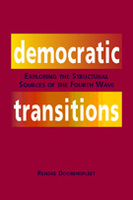
- 2005/203 pages
Democratic Transitions:
Exploring the Structural Sources of the Fourth Wave
Hardcover: $52.00
ISBN: 978-1-58826-306-3
With the widespread movement toward democratization that characterized the first post-Cold War decade, why did some nondemocratic regimes undergo a transition toward a democratic political system, but others not? Why have some transitions succeeded completely, but others resulted in only limited political reform? Renske Doorenspleet addresses these questions, providing a systematic theoretical and empirical analysis of variations in transitions to democracy.
Doorenspleet interweaves a discussion of key concepts, the major theoretical approaches to democratization, and statistical analyses to illuminate the influence of structural primarily economic and social factors on democratic transitions. She also explores the notion of "waves" of democratization. Though focusing on the 1989-2001 period, she offers a wealth of new evidence covering two centuries of democratic transitions around the globe.
No rights in South Asia





